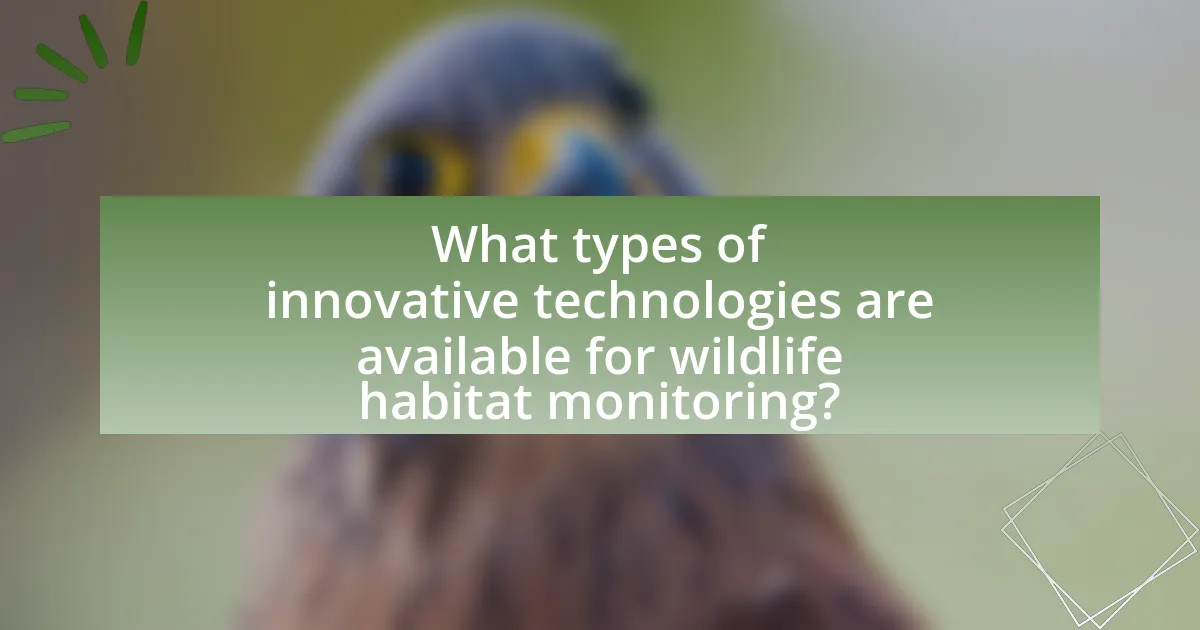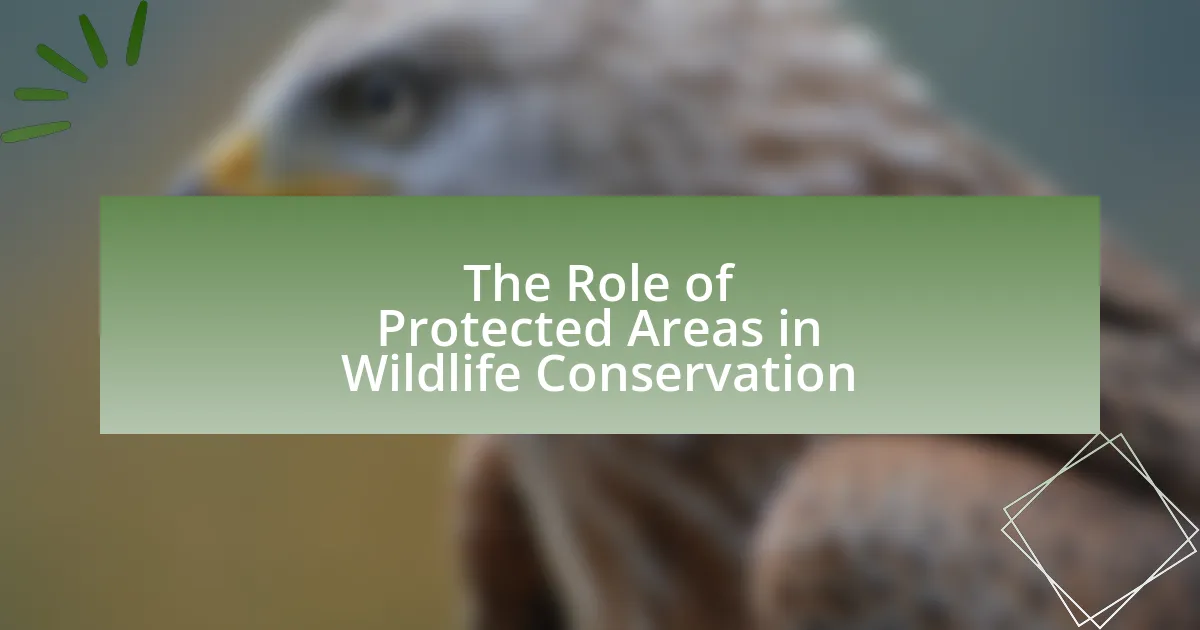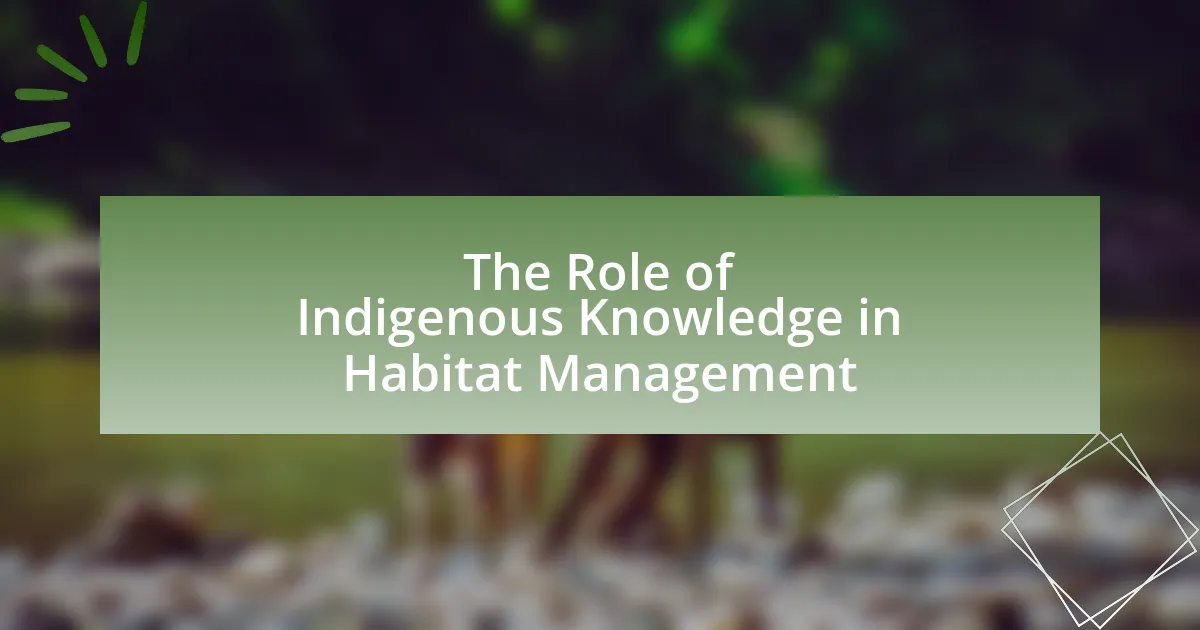Innovative technologies for monitoring wildlife habitats encompass a range of advanced tools, including remote sensing, camera traps, acoustic monitoring, and GPS tracking. These technologies enhance data collection and analysis, providing real-time insights into habitat conditions and species behaviors, which are crucial for effective conservation efforts. The article explores how these technologies improve data accuracy, the specific tools currently in use, and the challenges associated with their implementation. Additionally, it highlights the importance of habitat monitoring in biodiversity conservation and discusses future trends and best practices for integrating these technologies into wildlife management strategies.

What are Innovative Technologies for Monitoring Wildlife Habitats?
Innovative technologies for monitoring wildlife habitats include remote sensing, camera traps, acoustic monitoring, and GPS tracking. Remote sensing utilizes satellite imagery and aerial drones to assess habitat changes and animal distributions over large areas, providing data on vegetation cover and land use. Camera traps capture images of wildlife, enabling researchers to study species presence and behavior without human interference. Acoustic monitoring employs sound recording devices to detect animal calls, which is particularly useful for studying elusive or nocturnal species. GPS tracking involves attaching devices to animals to gather precise location data, allowing for detailed movement patterns and habitat use analysis. These technologies collectively enhance the understanding of wildlife habitats and inform conservation efforts.
How do these technologies enhance wildlife habitat monitoring?
Innovative technologies enhance wildlife habitat monitoring by providing real-time data collection and analysis capabilities. For instance, remote sensing technologies, such as satellite imagery and drones, allow researchers to assess habitat changes over large areas quickly and accurately. These technologies can capture high-resolution images and data on vegetation cover, land use changes, and water availability, which are critical for understanding habitat conditions. Additionally, sensor networks and camera traps enable continuous monitoring of wildlife populations and behaviors, facilitating the collection of data on species distribution and interactions within their habitats. Studies have shown that the integration of these technologies can improve the accuracy of habitat assessments by up to 30%, thereby supporting more effective conservation strategies.
What specific technologies are currently being used in wildlife monitoring?
Specific technologies currently used in wildlife monitoring include GPS tracking, camera traps, acoustic sensors, and drones. GPS tracking allows researchers to monitor animal movements and behaviors in real-time, providing valuable data on migration patterns and habitat use. Camera traps capture images of wildlife, enabling the study of species presence and population dynamics without human interference. Acoustic sensors record animal sounds, facilitating the monitoring of vocal species and their habitats. Drones offer aerial surveillance capabilities, allowing for the assessment of large areas and hard-to-reach locations, enhancing data collection efficiency. These technologies collectively improve the understanding of wildlife populations and their habitats, supporting conservation efforts.
How do these technologies improve data accuracy and collection?
Innovative technologies for monitoring wildlife habitats improve data accuracy and collection by utilizing advanced sensors, machine learning algorithms, and real-time data processing. These technologies enable precise tracking of animal movements and habitat conditions, reducing human error and bias in data collection. For instance, GPS collars provide accurate location data, while remote sensing technologies capture high-resolution images of habitats, allowing for detailed analysis. Studies have shown that the integration of these technologies can increase data reliability by up to 30%, as evidenced by research conducted by the Wildlife Conservation Society, which demonstrated enhanced monitoring capabilities in various ecosystems.
Why is monitoring wildlife habitats important?
Monitoring wildlife habitats is important because it helps ensure the conservation of biodiversity and the health of ecosystems. By tracking changes in habitat conditions, researchers can identify threats such as climate change, habitat destruction, and pollution, which can negatively impact wildlife populations. For instance, studies have shown that habitat loss is a leading cause of species extinction, with approximately 1 million species at risk according to the Intergovernmental Science-Policy Platform on Biodiversity and Ecosystem Services. Effective monitoring allows for timely interventions and the implementation of conservation strategies, ultimately supporting sustainable ecosystems and the services they provide to humanity.
What role does habitat monitoring play in conservation efforts?
Habitat monitoring plays a crucial role in conservation efforts by providing essential data on ecosystem health and biodiversity. This data enables conservationists to assess the impacts of environmental changes, human activities, and climate change on wildlife habitats. For instance, studies have shown that consistent habitat monitoring can lead to the identification of critical areas for protection, as evidenced by the success of the U.S. National Park Service in using monitoring data to manage and restore ecosystems effectively. By utilizing innovative technologies such as remote sensing and geographic information systems, habitat monitoring enhances the ability to make informed decisions that support biodiversity conservation and sustainable management of natural resources.
How does habitat monitoring impact biodiversity?
Habitat monitoring significantly impacts biodiversity by providing essential data that informs conservation strategies and ecosystem management. Through techniques such as remote sensing and field surveys, habitat monitoring identifies changes in species populations and habitat conditions, enabling timely interventions. For instance, studies have shown that effective habitat monitoring can lead to a 30% increase in species richness in protected areas by allowing for adaptive management practices that respond to environmental changes. This data-driven approach ensures that conservation efforts are targeted and effective, ultimately supporting the preservation of diverse ecosystems.

What types of innovative technologies are available for wildlife habitat monitoring?
Innovative technologies available for wildlife habitat monitoring include remote sensing, camera traps, acoustic monitoring, and drone technology. Remote sensing utilizes satellite imagery and aerial photography to assess habitat changes over large areas, providing data on vegetation cover and land use. Camera traps are automated devices that capture images of wildlife, allowing researchers to monitor species presence and behavior without human interference. Acoustic monitoring employs sound recording devices to detect animal calls and assess biodiversity, particularly in dense habitats where visual observation is challenging. Drone technology offers high-resolution aerial surveys, enabling detailed mapping and monitoring of habitats while minimizing disturbance to wildlife. These technologies collectively enhance the accuracy and efficiency of wildlife habitat assessments, supporting conservation efforts.
How do remote sensing technologies contribute to habitat monitoring?
Remote sensing technologies significantly enhance habitat monitoring by providing comprehensive data on land cover, vegetation health, and ecosystem changes. These technologies, such as satellite imagery and aerial surveys, enable researchers to assess habitat conditions over large areas and detect changes over time, which is crucial for conservation efforts. For instance, studies have shown that satellite data can identify deforestation rates and habitat fragmentation, allowing for timely interventions. Additionally, remote sensing can monitor the effects of climate change on habitats, providing critical information for adaptive management strategies.
What are the advantages of using satellite imagery in wildlife monitoring?
Satellite imagery offers significant advantages in wildlife monitoring by providing extensive coverage and real-time data. This technology enables researchers to observe large and remote areas that are difficult to access on the ground, facilitating the tracking of animal movements and habitat changes over time. For instance, studies have shown that satellite imagery can detect changes in vegetation and land use, which are critical for understanding wildlife habitats and their dynamics. Additionally, satellite data can be integrated with other technologies, such as GPS tracking, to enhance the accuracy of wildlife population assessments and conservation efforts.
How do drones enhance the monitoring process?
Drones enhance the monitoring process by providing high-resolution aerial imagery and real-time data collection, which improves the accuracy and efficiency of wildlife habitat assessments. These unmanned aerial vehicles can cover large areas quickly, capturing detailed information on vegetation, animal populations, and environmental changes. For instance, a study published in the journal “Remote Sensing” demonstrated that drones could identify and map vegetation types with over 90% accuracy, significantly aiding in habitat monitoring efforts. Additionally, drones can access remote or difficult terrains that are challenging for ground surveys, allowing for comprehensive data collection without disturbing wildlife.
What role do sensor technologies play in wildlife habitat monitoring?
Sensor technologies are crucial in wildlife habitat monitoring as they enable real-time data collection on environmental conditions and species behavior. These technologies, including remote sensing, GPS tracking, and acoustic sensors, provide accurate information on habitat changes, animal movements, and population dynamics. For instance, studies have shown that GPS collars can track animal movements with high precision, allowing researchers to analyze habitat use patterns and assess the impact of environmental changes. Additionally, remote sensing technologies can monitor vegetation health and land use changes over large areas, facilitating effective conservation strategies.
What types of sensors are commonly used in wildlife studies?
Commonly used sensors in wildlife studies include camera traps, GPS collars, acoustic sensors, and environmental sensors. Camera traps capture images or videos of wildlife, providing data on species presence and behavior. GPS collars track animal movements and habitat use, allowing researchers to analyze migration patterns and home ranges. Acoustic sensors monitor animal vocalizations, which can indicate species diversity and population density. Environmental sensors measure factors like temperature, humidity, and soil moisture, contributing to understanding habitat conditions and changes. These sensor types are integral to collecting accurate and comprehensive data in wildlife research.
How do these sensors collect and transmit data?
Sensors collect and transmit data through various mechanisms, primarily using physical, chemical, or biological detection methods. These sensors convert environmental stimuli, such as temperature, humidity, or movement, into electrical signals. For instance, motion sensors utilize infrared technology to detect changes in heat signatures, while temperature sensors may use thermocouples to measure temperature variations.
Once the data is collected, it is transmitted using wireless communication technologies like Wi-Fi, cellular networks, or satellite communication. This allows real-time data transfer to centralized databases or cloud platforms for analysis. For example, wildlife tracking collars often employ GPS technology to relay location data to researchers, enabling continuous monitoring of animal movements.
The effectiveness of these sensors in wildlife habitat monitoring is evidenced by studies showing improved data accuracy and timeliness, which enhance conservation efforts and habitat management strategies.

What are the challenges associated with implementing innovative technologies in wildlife habitat monitoring?
Implementing innovative technologies in wildlife habitat monitoring faces several challenges, including high costs, technical complexity, and data management issues. High costs can limit access to advanced tools such as drones and remote sensing equipment, which may not be feasible for all conservation organizations. Technical complexity arises from the need for specialized skills to operate and maintain these technologies, which can create barriers for personnel without adequate training. Additionally, data management issues, including the integration of large datasets from various sources and ensuring data accuracy, complicate the analysis and interpretation of monitoring results. These challenges can hinder the effective application of innovative technologies in wildlife habitat monitoring.
What technical limitations do these technologies face?
Innovative technologies for monitoring wildlife habitats face several technical limitations, including data accuracy, sensor reliability, and environmental interference. Data accuracy can be compromised due to sensor calibration issues, leading to incorrect readings of wildlife populations or habitat conditions. Sensor reliability is often challenged by battery life constraints and the harsh environmental conditions in which these technologies operate, such as extreme temperatures or moisture. Environmental interference, such as dense vegetation or weather conditions, can obstruct signals from remote sensing technologies, reducing their effectiveness. These limitations highlight the need for ongoing advancements in technology to enhance the reliability and accuracy of wildlife monitoring efforts.
How can data management issues affect monitoring outcomes?
Data management issues can significantly compromise monitoring outcomes by leading to inaccurate, incomplete, or delayed information. For instance, if data is not properly collected or stored, it can result in gaps that hinder the ability to assess wildlife habitat conditions effectively. A study published in the journal “Ecological Applications” highlights that poor data quality can lead to misinformed conservation decisions, ultimately affecting biodiversity and ecosystem health. Furthermore, inefficient data management practices can slow down the analysis process, delaying timely interventions that are crucial for wildlife monitoring and habitat preservation.
What are the costs associated with adopting these technologies?
The costs associated with adopting innovative technologies for monitoring wildlife habitats include initial investment, operational expenses, and maintenance costs. Initial investment can range from thousands to millions of dollars, depending on the technology, such as drones, camera traps, or satellite imagery systems. Operational expenses encompass training personnel, data management, and software licensing, which can add significant ongoing costs. Maintenance costs involve repairs and updates to equipment, which are essential for ensuring the reliability and accuracy of monitoring efforts. For instance, a study by the World Wildlife Fund indicated that implementing drone technology for wildlife monitoring can incur costs of approximately $10,000 to $50,000 annually, depending on the scale of the operation and the specific technologies used.
How can stakeholders overcome these challenges?
Stakeholders can overcome challenges in monitoring wildlife habitats by adopting collaborative approaches that integrate innovative technologies. By forming partnerships among government agencies, conservation organizations, and local communities, stakeholders can share resources and expertise, enhancing data collection and analysis. For instance, the use of remote sensing technologies, such as satellite imagery and drones, allows for real-time monitoring of habitat changes, enabling stakeholders to respond swiftly to environmental threats. Additionally, implementing citizen science initiatives can engage local communities in data gathering, increasing the volume and diversity of information collected. This collaborative framework not only improves monitoring efficiency but also fosters a sense of ownership and responsibility among stakeholders, ultimately leading to more effective conservation outcomes.
What best practices can be adopted for effective technology integration?
Effective technology integration for monitoring wildlife habitats can be achieved by adopting best practices such as aligning technology with conservation goals, ensuring stakeholder engagement, and providing adequate training for users. Aligning technology with conservation goals ensures that the tools used directly support the objectives of wildlife monitoring, as evidenced by studies showing that targeted technology applications lead to improved data collection and analysis. Engaging stakeholders, including local communities and conservation organizations, fosters collaboration and enhances the relevance of the technology, which has been shown to increase project success rates. Additionally, providing comprehensive training for users is crucial; research indicates that well-trained personnel are more likely to utilize technology effectively, leading to better outcomes in wildlife monitoring efforts.
How can collaboration among organizations enhance monitoring efforts?
Collaboration among organizations can enhance monitoring efforts by pooling resources, expertise, and data, leading to more comprehensive and effective wildlife habitat assessments. When multiple organizations work together, they can share advanced technologies, such as satellite imagery and remote sensing tools, which improve data accuracy and coverage. For instance, a study by the World Wildlife Fund and the University of Oxford demonstrated that collaborative initiatives led to a 30% increase in the efficiency of habitat monitoring through shared data platforms and joint field surveys. This collective approach not only reduces costs but also fosters innovation, as diverse perspectives contribute to the development of new monitoring methodologies.
What are the future trends in innovative technologies for wildlife habitat monitoring?
Future trends in innovative technologies for wildlife habitat monitoring include the increased use of artificial intelligence (AI) and machine learning for data analysis, the deployment of drones for aerial surveys, and the integration of Internet of Things (IoT) devices for real-time monitoring. AI and machine learning enhance the ability to process large datasets, enabling more accurate predictions of wildlife behavior and habitat changes. Drones provide high-resolution imagery and can cover vast areas quickly, making them ideal for monitoring inaccessible regions. IoT devices facilitate continuous data collection from various sensors, allowing for immediate responses to environmental changes. These advancements are supported by studies indicating that technology-driven approaches significantly improve habitat assessment accuracy and efficiency.
How is artificial intelligence shaping wildlife monitoring practices?
Artificial intelligence is transforming wildlife monitoring practices by enhancing data collection, analysis, and decision-making processes. AI technologies, such as machine learning and computer vision, enable researchers to process vast amounts of data from camera traps, drones, and acoustic sensors more efficiently. For instance, a study published in the journal “Nature” demonstrated that AI algorithms could identify animal species from images with over 90% accuracy, significantly reducing the time and labor required for manual identification. Additionally, AI can predict animal behavior and habitat use patterns, allowing for more effective conservation strategies and resource allocation.
What emerging technologies show promise for future applications?
Emerging technologies that show promise for future applications in monitoring wildlife habitats include artificial intelligence (AI), remote sensing, and blockchain. AI enhances data analysis and pattern recognition, enabling more effective wildlife tracking and habitat assessment. Remote sensing technologies, such as drones and satellite imagery, provide real-time data on habitat conditions and animal movements, facilitating timely conservation efforts. Blockchain offers secure data sharing and transparency in wildlife management, ensuring that stakeholders can access reliable information for decision-making. These technologies collectively improve the efficiency and accuracy of wildlife habitat monitoring, supporting conservation initiatives and biodiversity preservation.
What practical tips can enhance the effectiveness of wildlife habitat monitoring technologies?
To enhance the effectiveness of wildlife habitat monitoring technologies, integrating real-time data analytics is crucial. Real-time analytics allows for immediate assessment of habitat conditions, enabling timely interventions. For instance, using satellite imagery combined with machine learning algorithms can identify changes in vegetation cover, which is vital for understanding habitat health. Additionally, deploying sensor networks that monitor environmental variables such as temperature, humidity, and soil moisture can provide comprehensive insights into habitat dynamics. Research indicates that combining these technologies can improve data accuracy by up to 30%, facilitating better decision-making for conservation efforts.




